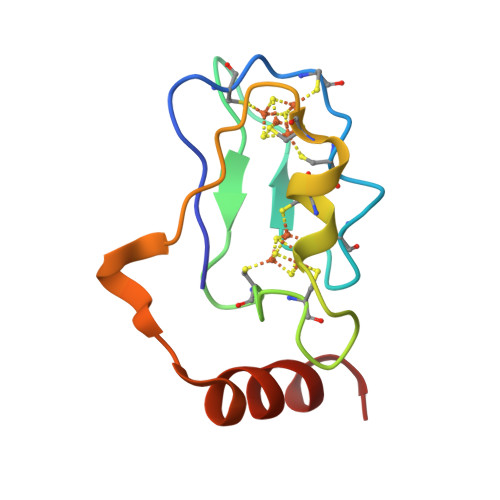Crystallization of 4-hydroxybenzoyl-CoA reductase and the structure of its electron donor ferredoxin.
Unciuleac, M., Boll, M., Warkentin, E., Ermler, U.(2004) Acta Crystallogr D Biol Crystallogr 60: 388-391
- PubMed: 14747735
- DOI: https://doi.org/10.1107/S0907444903028506
- Primary Citation of Related Structures:
1RGV - PubMed Abstract:
4-Hydroxybenzoyl-CoA reductase (4-HBCR) is a central enzyme in the metabolism of phenolic compounds in anaerobic bacteria. The enzyme catalyzes the reductive removal of the phenolic hydroxyl group from 4-hydroxybenzoyl-CoA, yielding benzoyl-CoA and water. 4-HBCR belongs to the xanthine oxidase (XO) family of molybdenum enzymes which occur as heterodimers, (alphabetagamma)(2). 4-HBCR contains two molybdopterins, four [2Fe-2S] and two [4Fe-4S] clusters and two FADs. A low-potential Allochromatium vinosum-type ferredoxin containing two [4Fe-4S] clusters serves as an in vivo electron donor for 4-HBCR. In this work, the oxygen-sensitive proteins 4-HBCR and the ferredoxin (TaFd) from Thauera aromatica were crystallized under anaerobic conditions. 4-HBCR crystallized with PEG 4000 and MPD as precipitant diffracted to about 1.6 A resolution and the crystals were highly suitable for X-ray structure analysis. Crystals of TaFd were obtained with (NH(4))(3)PO(4) as precipitant and revealed a solvent content of 77%, which is remarkably high for a small soluble protein. The structure of TaFd was solved at 2.9 A resolution by the molecular-replacement method using the highly related structure of the ferredoxin (CvFd) from A. vinosum as a model. Structural changes between the two ferredoxins around the [4Fe-4S] cluster can be correlated with their different redox potentials.
Organizational Affiliation:
Institut für Biologie II, Mikrobiologie, Schänzlestrasse 1, D-79104 Freiburg, Germany.

















